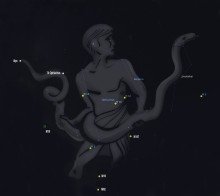Recent cloudy nights and rain has meant that observing opportunities have been pretty scarce (I’ve been out only once in the past two weeks!). The ‘upside’ of this is that’s there’s been time for research and planning …
Whilst perusing Stellarium on the computer I happened upon the constellations of Ophiuchus and Serpens (due south at this time of year, and also known as the serpent bearer and the serpent itself, respectively). Something about these constellations piqued my interest, and so I fetched my copy of Patrick Moore’s Observer’s Book of Astronomy to find out more. Alas, Moore’s conclusion was that “Ophiuchus is dull and barren, and there are few objects of interest in it”, and of Serpens he says, “The only notable object is a fine double …”
The double star Moore mentions is Alya, at the very end of the serpent’s tail. I actually haven’t checked it out myself, but it’s now added to my watch list. 70 Ophiuchus is another binary star, the components being yellow/orange and orange. Visible to the naked eye as a dim star, you’ll need a telescope to split the two components. Another notable star in the region is Alpha Serpentis (Unukalhai) – a red giant, and also visible to the naked eye.
Eight Messier catalogue globular star clusters lie within the Ophiuchus/Serpens area: Messiers 14, 10, 12, 9, 107, 19, 62, and 5. The latter is (just) visible to the naked eye on a very good night, and all the others should be visible in 10×50 binoculars; greater magnification and better light gathering will reveal more detail.
M5 is thought to be one of the oldest globular clusters in the galaxy; something in the order of 13 billion years old (almost as old as the universe itself!). It contains somewhere between 100,000 and 500,000 stars.
Messier 10 and 12 are located within Ophiuchus, appear fairly close to one another, are similar in size, and appear fairly small and dense, even when viewed with a telescope. Messier 14, though, to the left of these two, is quite large; like M5. Made up of several hundred thousand stars, M14 is 400,000 times as luminous as our Sun.
M19, at the bottom of Ophiuchus, is very nice; described by John Herschel, son of William, as “… a superb cluster resolvable into countless stars”. It’s well worth a look. Its mass is estimated to be in the region of 1.1 million times that of the Sun!
M62 is similar in appearance to Ms 10 and 12, and lies below Ophiuchus, very close to the constellation of Scorpius.
I mentioned M16 (the Eagle nebula) in my last piece, and actually got to see it again recently. Viewing conditions weren’t great on the night, unfortunately, and I couldn’t see any nebulosity, or the amazing ‘Pillars of creation’, but I did see the star cluster that lies within the nebula very clearly. I remember the first time I saw the Hubble images of the Pillars of Creation, taken back in 1995, and being completely blown away by them. This really is a spectacular object, and is ideally placed for viewing at the moment.
I think you’ll agree, the area around Ophiuchus/Serpens is far from dull.
What’s up?
All the above mentioned globular clusters are well placed for observing at the moment, and are easy to find with the help of a smart phone app, such as Stellarium or Google Sky Map.
If you’re up after midnight, and have a clear view to the eastern horizon, you should be able to catch Neptune rising. It’s too faint to be seen with the naked eye, but 10×50 binoculars will clearly reveal that this particular bright point of light isn’t a star. Moderate telescopes will reveal the blue-ish/green orb.
I watched Neptune rising a few nights ago, alongside the moon, and it easily ranked in the top five of my astronomy experiences! Small, shimmery, and lacking detail, one has to bring one’s imagination to bear, somewhat, but if you remember that this is an ice giant planet in the outer reaches of our solar system (on average 4496 million kilometres away), has a diameter of around 50,000km, eight known moons, and a ring system, you have to admit that it’s pretty cool (pardon the pun)!
Clear skies!
Kevin Quinn is an amateur astronomer based in Cerne Abbas. He is the proud owner of a ten-inch reflector, a small refractor, a case of eyepieces, and a couple of pairs of binoculars. He tweets via @CerneAstro, and blogs via theastroguy.wordpress.com.
©Kevin Quinn












